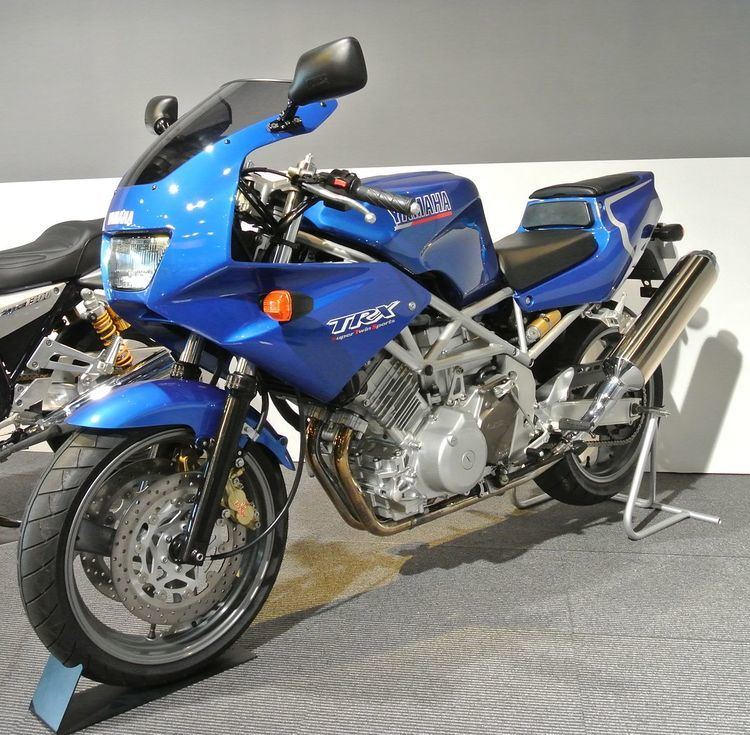Class Sport bike | Also called TRX | |
 | ||
Production 1995 (japan only)1996 - 2000 Engine 850 cc crossplane parallel-twin Bore / stroke 89.5 mm × 67.5 mm (3.52 in × 2.66 in) | ||
The Yamaha TRX850 is a sports motorcycle with a 10-valve dohc 849 cc 270° parallel-twin engine. Yamaha first released it in Japan in 1995, and a version for the European market became available in 1996 to 2000.
Contents
Design and development
The TRX engine was derived from that in the Yamaha TDM850 and has five valves per cylinder, three inlet and two exhaust. The engine produces some 85 Nm of torque and 79 bhp. Unusually for a dry sump design, the oil tank is not remote, but is integral to the engine, sitting atop the gearbox. This feature simplifies manufacture, eradicates external oil lines, and gives faster oil warm-up. The shallow sump allows the engine to be sited lower, for an optimal CG position. The 360° crank of the original TDM was changed to a 270° crank for both the TRX and later TDMs. The engine has a balance shaft to smooth out vibrations.The front forks are conventional telescopics, and the rear suspension is a rising-rate monoshock unit, with a bikini fairing, clip-on handlebars and mildly rear-set footrests, the TRX has minimal provision for a pillion passenger. The TRX is lighter, lower and sportier than its TDM stablemate. In 2000 Yamaha stopped making the TRX, while the TDM series, enlarged to 900 cc, remained in production until 2011.
While the version for the Japanese home market had Italian Brembo brake callipers, the European version had Yamaha callipers.
Reception
The TRX was designed to compete in the market with the Ducati 900SS V-twin, whose tubular trellis frame it mimicked. Although developed cheaply from Yamaha's "parts bin", using a modified TDM850 engine and FZR cycle parts, the TRX performs well and has "a coherent identity of its own". Motorcycle journalist Kevin Ash declared the TRX to be one of the seven "most underrated motorcycles", describing the TRX as a "bitsa" bike that is greater than the sum of its parts.
In Motorcycle News (MCN) the TRX was later described as "the best-kept secret in motorcycling" and a "forgotten gem" which bore comparison with the 270° Norton Commando 961. The MCN review states: "The TRX produces less power than sports 600s of the same era, but it’s much gruntier and more satisfying to use thanks to that twin cylinder character". The review added: "The TRX is a cracking bike, a sporty motorcycle with tons of character. It's stable, handles neutrally and feels like a proper sports bike". In 2014, Steve Cooper wrote of the TRX: "Very much the thinking man's sports bike, this slightly oddball twin is beginning to reach cult status and for good reason; with a little work it's possible to see a genuine 100bhp...".
Although considerably cheaper than the Ducati, TRX sales were disappointing, and production ceased in 2000. The bike has since achieved a latter-day popularity, but there has been no obvious successor.
The 270° crankshaft
Although the 270° crank concept has been attributed to Australian Phil Irving (of Vincent renown), the TRX was the first production motorcycle to feature this innovation. The 270° crank has an ignition sequence and an engine balance that yields something of the feel of a V-twin. Unlike 180° & 360° parallel-twins, a 270° engine in motion never has both pistons stationary, so its flywheel momentum is continuous. With less vibration than a 360° crank, and a more regular firing pattern than a 180° crank, a 270° crank results in a smoother engine. Any residual unevenness of the 270° firing interval has been claimed to deliver power to the rear tyre more effectively.
The concept appears to be an ideal compromise, and the 270° crank is becoming the optimal configuration for large parallel-twins. The 2009 Triumph Thunderbird, the "Donington" Norton Commando 961, and the Yamaha MT-07 are all 270° designs. The 2016 Honda 1000cc Africa Twin has a 270° parallel-twin, (rather than the V-twin of earlier incarnations). While the 900cc Triumph Thruxton had 360° cranks, the new 1200cc Thruxtons have 270° cranks. The KTM 800cc parallel-twin roadster is to be a 270° design. (Bucking the trend, the short-lived 2001 MZ 1000S was a 180° twin; but despite having balance shafts, the MZ engine still exhibits some vibration).
